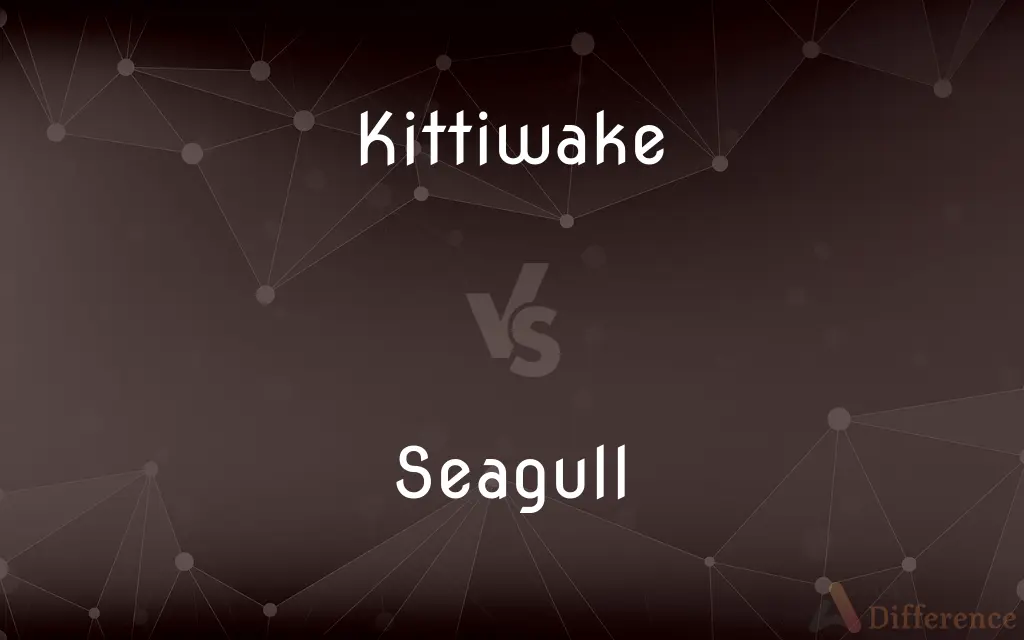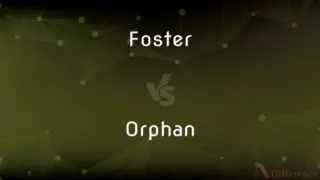Kittiwake vs. Seagull — What's the Difference?
By Tayyaba Rehman & Fiza Rafique — Updated on March 9, 2024
Kittiwake is a specific type of gull with distinct breeding habits and habitats, while seagull encompasses a broad range of gull species with varied behaviors.

Difference Between Kittiwake and Seagull
Table of Contents
ADVERTISEMENT
Key Differences
Kittiwakes are a unique species within the gull family, known for their cliff-nesting habits and smaller size compared to some other gull species. They are primarily found in the colder regions of the North Atlantic and North Pacific. Seagulls, on the other hand, refer to a wide variety of gull species that are more adaptable and can be found in diverse environments, from coastal areas to inland regions, and even urban settings.
Kittiwakes have a more specific diet, primarily feeding on fish and small marine organisms, which they catch by skillful hovering and diving near the water's surface. Seagulls have a more varied diet, often including insects, small mammals, and food waste from human activities, showcasing their opportunistic feeding behavior.
In terms of behavior, Kittiwakes are less likely to be found near human habitats and are more at home in the isolated cliff sides where they breed. Seagulls are known for their adaptability and are often seen in close proximity to human settlements, where they can scavenge for food.
Reproductively, Kittiwakes are known for their monogamous nature, often returning to the same nesting sites with the same partners year after year. Seagulls, while also often monogamous, may exhibit a wider range of breeding behaviors and nest in more varied environments, from ground nests to rooftop colonies.
Conservation status is another point of difference; some Kittiwake populations, particularly the Black-legged Kittiwake, are considered vulnerable due to changes in their marine environments. Seagulls, with their adaptability, tend to have more stable populations, though specific species may also face threats from pollution and habitat loss.
ADVERTISEMENT
Comparison Chart
Habitat
Colder regions, cliffs
Diverse, including urban areas
Diet
Mainly fish and marine organisms
Varied, includes waste and small mammals
Human Interaction
Less common near human habitats
Often found near humans, scavenging
Breeding
Cliff-nesting, monogamous
Varied nesting sites, generally monogamous
Conservation
Some species vulnerable
Generally stable, some species threatened
Compare with Definitions
Kittiwake
A type of gull known for nesting on cliffs.
The kittiwake colony was noisy with the sound of chicks.
Seagull
Diet includes a wide range of food sources.
The seagull snatched a piece of bread from the picnic table.
Kittiwake
Primarily feeds on fish by hovering and diving.
We watched a kittiwake skillfully catch a fish near the surface.
Seagull
Encompasses various gull species adaptable to different environments.
Seagulls were scavenging for food at the beach.
Kittiwake
Monogamous with high site fidelity for breeding.
Each year, the same pair of kittiwakes returned to their nest.
Seagull
Populations are generally stable, but some face threats.
Certain seagull species are threatened by urban development.
Kittiwake
Less likely to interact with humans.
Unlike other gulls, a kittiwake rarely ventures into urban areas.
Seagull
Common in coastal and urban areas.
Seagulls are a familiar sight in the city's waterfront districts.
Kittiwake
Vulnerable due to environmental changes.
The kittiwake population is declining due to the loss of suitable marine habitats.
Seagull
Breeding behaviors and sites vary widely.
A pair of seagulls made a nest on the abandoned building's roof.
Kittiwake
The kittiwakes (genus Rissa) are two closely related seabird species in the gull family Laridae, the black-legged kittiwake (Rissa tridactyla) and the red-legged kittiwake (Rissa brevirostris). The epithets "black-legged" and "red-legged" are used to distinguish the two species in North America, but in Europe, where Rissa brevirostris is not found, the black-legged kittiwake is often known simply as kittiwake, or more colloquially in some areas as tickleass or tickleace.
Seagull
A gull, especially one found near coastal areas.
Kittiwake
Either of two gray gulls, Rissa tridactyla or R. brevirostris of northern oceans, that nest in colonies on sea cliffs.
Seagull
Any of several white, often dark backed birds of the family Laridae having long pointed wings and short legs.
Kittiwake
Either of two small gulls in the genus Rissa of the family Laridae that nest in colonies on sea cliffs and spend the winter on the open ocean.
Seagull
(orthography) The symbol ̼ , which combines under a letter as a sort of accent.
Kittiwake
A northern gull (Rissa tridactyla), inhabiting the coasts of Europe and America. It is white, with black tips to the wings, and has only three toes.
Seagull
A fan or member of Brighton and Hove Albion Football Club.
Kittiwake
Small pearl-gray gull of northern regions; nests on cliffs and has a rudimentary hind toe
Seagull
To run in the back line rather than concentrate on primary positional duties in open play.
Seagull
To use a British Seagull outboard.
Seagull
(New Zealand) To work as a non-union casual stevedore.
Seagull
Mostly white aquatic bird having long pointed wings and short legs
Common Curiosities
What distinguishes a kittiwake from other gulls?
Kittiwakes are known for their cliff-nesting habits and smaller size.
Are seagulls considered pests in urban areas?
In some cases, due to their scavenging behavior and adaptability.
How do seagulls adapt to urban environments?
They scavenge food waste and can nest on buildings and other structures.
What is the diet of a kittiwake compared to a typical seagull?
Kittiwakes primarily eat fish, while seagulls have a more varied diet.
Can kittiwakes be found away from the sea?
Rarely, as they are closely tied to marine environments for feeding and breeding.
How do seagulls communicate?
Seagulls use a variety of calls and body language to communicate.
Are kittiwakes endangered?
Some populations, like the Black-legged Kittiwake, are considered vulnerable.
What is the typical breeding behavior of a kittiwake?
They are monogamous and return to the same nesting sites annually.
What measures are being taken to protect vulnerable kittiwake populations?
Conservation efforts include habitat protection and monitoring of marine food sources.
Do seagulls migrate?
Many seagull species migrate, but patterns can vary widely among species.
How do kittiwakes catch their food?
They hover and dive near the water's surface to catch fish.
Can seagulls and kittiwakes coexist in the same area?
They can coexist, but typically occupy different niches within their environments.
What is the lifespan of a kittiwake compared to a typical seagull?
Lifespan can vary, but many gull species can live for 10-15 years or more under the right conditions.
What threats do seagulls face?
Pollution, habitat loss, and in some areas, conflict with humans.
Why are kittiwakes less common in urban areas than seagulls?
Kittiwakes prefer isolated cliff sides for nesting and are less adaptable to urban settings.
Share Your Discovery

Previous Comparison
Bleach vs. Disinfectant
Next Comparison
Foster vs. OrphanAuthor Spotlight
Written by
Tayyaba RehmanTayyaba Rehman is a distinguished writer, currently serving as a primary contributor to askdifference.com. As a researcher in semantics and etymology, Tayyaba's passion for the complexity of languages and their distinctions has found a perfect home on the platform. Tayyaba delves into the intricacies of language, distinguishing between commonly confused words and phrases, thereby providing clarity for readers worldwide.
Co-written by
Fiza RafiqueFiza Rafique is a skilled content writer at AskDifference.com, where she meticulously refines and enhances written pieces. Drawing from her vast editorial expertise, Fiza ensures clarity, accuracy, and precision in every article. Passionate about language, she continually seeks to elevate the quality of content for readers worldwide.
















































